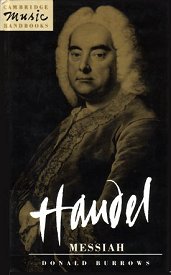
| BOOKS | |||||||||||||||||||||||||||||
|
|
DESCRIPTION: Donald Burrows brings many new
insights to this fascinating account of one
of the favorite works of the concert hall.
He traces the course of Messiah from
Handel's initial musical response to the
libretto, through the oratorio's turbulent
first years to its eventual popularity with
the Foundling Hospital performances. The
book addresses such questions as the
position of Messiah within the oratorio
genre, Handel's treatment of structural
design, tonal relationships in the work and
problems of English wordsetting, as well as
contemporary issues such as Handel's
relationship with his librettist, Charles
Jennens, and with his performers and
audience.
|
|
SITE RATING: 10/10 SITE
REVIEW: This small,
densely-written handbook, published by
Cambridge University Press by author Donald
Burrows, is arguably the very best to offer an
in-depth examination of all the aspects of
Handel's Messiah.
Burrows, a Senior Lecturer in Music at The
Open University, digs very deeply into both
the history and musicology of Messiah, giving
over the first chapters to Handel's immersion
in German and Italian musical forms, briefly
examining Handel's first foray into English
oratorio in Esther;
then traces the path from that work to Messiah.
He
touches upon Charles Jennins and his and
Handel's working relationship, the Dublin
premiere, the music and performers used for
that first performance, and then spends a
chapter examining the first London
performances. The final final four
chapters penetrate deeply into the different
forms Messiah took over the years, with both
Handel's pen, and then through the nineteenth
century to the late 1980s; with a chapter
devoted to the 'design' of Messiah,
placing it within the oratorio form,
discussing the libretto's form and content,
and its musical forms. He spends an
entire chapter dissecting individual arias and
movements, and touches on the orchestra's
contribution. Finally, in the eighth and
final chapter, he discusses 'word settings'
within Messiah.
Throughout
the book he uses period-appropriate letters
and newspaper reports, and finishes off the
book with lengthy appendices, noting sources
both musically and for the libretto, and gives
a partial bibliography. This book is
intended more for the serious musicologist,
although more casual admirers will find much
to enjoy within Burrows book as well - the
writing style is literate, but not heavy, and
while Burrows writes within a scholarly
framework, he is clearly a fan as well, and
his enthusiasm and thoroughness make this a
first choice for those who want a deep look
within Messiah.
|
